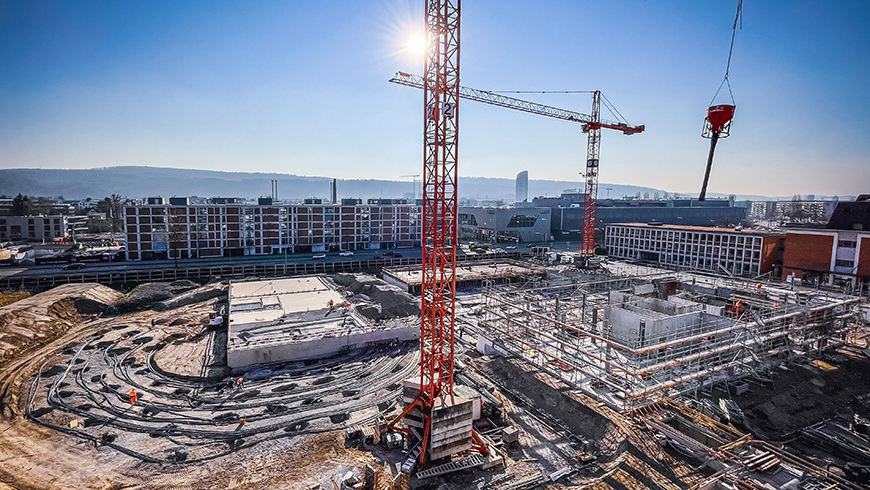Using models in a different way
Paradigm shift in energy planning

Numerous countries around the world have pledged to achieve climate neutrality by 2050. For these countries' building and energy systems, this means a rapid shift from fossil fuels to renewable energy. Moreover, there will be a much stronger interconnection and permanent interaction among different sectors and their systems: among the building stock, mobility and industry, and among electricity, heat and synthetic fuels. A wide variety of automation and control systems manage the production, transportation, storage, conversion, and use of energy. The building stock, in particular, can offer massive load flexibility with demand-side management, batteries, and thermal storage capacity. However, such interacting systems require a holistic, systemic view – and must be designed accordingly so that the net zero target is affordable while maintaining supply security.
Matthias Sulzer is a researcher in Empa's Urban Energy Systems lab and at the Lawrence Berkeley National Laboratory in California. Michael Wetter is a researcher in the Building Technology and Urban Systems Department at the Lawrence Berkeley National Laboratory. Both are familiar with the energy sectors in Switzerland and the USA and state: "Given the complexity and required flexibility of future energy systems, as well as the urgency for their transformation, current planning processes are inadequate." Despite efforts to overcome "silo thinking", the planning process for building and energy systems remains organized by discipline. For instance, an engineer develops the heating, ventilation and air conditioning (HVAC) system of a building based on the architect's plans and current regulations. The system design is then passed on to the building automation engineer, who, in turn, tries to find a suitable automation solution for the given specifications. "There is insufficient interaction between the disciplines to design buildings or energy infrastructures as holistic systems. Often only the interfaces for the handover from one discipline to another are addressed," explains Sulzer, comparing the procedure to a waterfall that flows linearly in one direction – downwards – without opportunities to revisit higher levels and introduce improvements for the overall system.
Moving away from manual labor to automation
Together with researchers from Berkeley and Empa, Sulzer and Wetter are advocating for a paradigm shift in the planning and construction process of building and district energy systems. Their inspiration comes from Alberto Sangiovanni-Vincentelli, a leading electronics and computer scientist at the University of California at Berkeley. His work significantly contributed to the transition of chip manufacturing from handcrafted design and production to highly automated processes in the 1980s. A joint study explores how Sangiovanni-Vincentelli's platform-based design, crucial in the chip industry, can be applied to energy system planning. The core elements of this concept involve different levels of abstraction where systems are analyzed and optimized holistically and interactively. At each level, universally applicable but individually combinable models are created, determining how a system will be specified and built.
"In the planning of buildings and energy systems today, new models are created on a case-by-case basis to better understand and evaluate existing or planned systems," explains Michael Wetter, referring to a scientific approach where models describe the object being analyzed. "But what if the models were not only used to understand how an object will behave, but also become the specification for how an object should be built? In this way, models serve as blueprints that clearly specify the design and functionality of a system." Sulzer believes that this shift towards a more engineering-oriented approach to models would be the first step towards a transformation similar to the one the chip and automotive industries underwent a few decades ago. "This paradigm shift can revolutionize our planning, construction, and operational processes and promote the digitalization and automation essential to achieving our ambitious decarbonization goals."
Pilot project at Empa
The first concrete application of the concept is the EU project GOES ("Geothermal-based Optimized Energy Systems"), which was launched in 2023 and is led by Empa and supported by the Swiss Federal Office of Energy (SFOE), among others. The project aims to develop an initial application for platform-based designs using pilot plants, including one on the Empa campus in Dübendorf. Practically, this involves defining the various levels of abstraction at which decision-making for the design of urban energy systems occurs and standardizing the interfaces.
One research object – many research perspectives
M Wetter, M Sulzer; A call to action for building energy system modelling in the age of decarbonization; Journal of Building Performance Simulation (2023); https://doi.org/10.1080/19401493.2023.2285824
M Sulzer, M Wetter, R Mutschler, A Sangiovanni-Vincentelli; Platform-Based Design for Energy Systems; Applied Energy (2023); https://doi.org/10.1016/j.apenergy.2023.121955
-
Share






